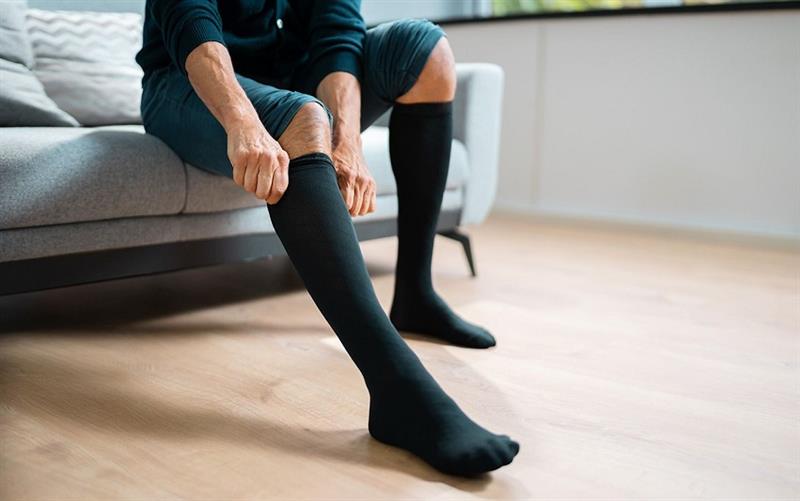
Since the pressure applied by compression socks decreases from your foot up to your knees (or legs), they are also referred to as "graduated" support socks. This helps your blood flow back up.
Medical conditions necessitate the use of graduated compression socks for some people, but you don't need a prescription to purchase them. In actuality, you can simply obtain them online or purchase them from a retailer. I didn't consider it, but if you travel frequently, you might want to find out if your health insurance supports prescribed compression socks before requesting a prescription from your physician.
Most Significant Benfefits Of Compression Socks For Travel
1. Warmer Feet
Yes, it can get chilly on public transit. Did you know that a shortage of oxygen in your bloodstream causes your feet to become noticeably colder when your blood isn't flowing properly? Compression hosiery will keep your feet (and entire body) warmer by assisting blood flow back to the heart for oxygen.
2.Less Legg Swelling
Lymph, a fluid that is present in the cells in your legs, flows more freely when compression stockings are worn. Your tissues experience a reduction in swelling when lymph can circulate more easily.
3. Avoid Vascular Blood Pooling In The Leg
Blood can collect in the veins of your feet and lower thighs after prolonged sitting. Blood pooling can result in a number of various symptoms, such as general leg swelling, ache, fatigue, and, in rare instances, a venous blood clot.
By compressing the vein walls in your legs as well as the tissues that line them, compression socks reduce these dangers and make it easier for blood to return to your heart.
4. Avoid Blood Clots
In a small percentage of instances, deep vein thrombosis (DVT) symptoms and blood clots are related. In the deep veins of the arms, chest, or legs, a DVT blood clot develops.
A pulmonary embolism is eventually brought on by the clots breaking off as they grow and traveling through the blood to your lungs.
Time spent flying or sitting still increases the risk of blood clots, particularly for flights or trips longer than seven hours. The constriction provides the leg arteries the pressure necessary to keep blood flow without clotting because the socks are the tightest at the ankles and get less constricted as they get to the thighs.
It's important to highlight that these advantages are only available to people who have never had blood clots before. If you have a history of DVT, talk to your doctor. He can advise you on how to reduce the risks and whether it is safe for you to travel while having DVT.
As you can see, compression hosiery and stockings have a ton of advantages, but which ones should you buy?
The best way to select compression socks for travel
In terms of height, size, style, and the amount of pressure they apply to your legs and feet, there are various kinds of compression stockings.
1. Compression Sock Selection - HEIGHT TYPES
- Travel socks for lengthy trips
- Compression tights
- Sock compression long trips
i) Your feet are not covered by calf compression covers.
II) Similar to sleeves, ankle compression socks only encompass your ankle and the back of your feet.
iii) Similar to ankle sleeves, open-toe compression stockings are typically knee-high.
iv) Regular compression socks and travel-specific compression socks are comparable to knee-high socks.
v) As the name suggests, compression thigh-highs are compression socks that reach your leg.
vi) Similar to pantyhose but with the added benefit of compression, compression support tights provide full-body support from the feet up. Additionally, you can purchase these as maternity compression stockings to wear over a growing abdomen.
vii) Leggings that provide support from the foot all the way up are called compression leggings.
2. Size Selection For Compression Socks
Compression socks are meant to be a little tight, so you might be wondering if they could hurt you.
Simply make sure you purchase the appropriate measurement. I have slightly larger calves than what I'd consider typical for my size, but a standard pair will do just fine. The hosiery should be snug, but not painfully so.
3. Style Guide For Selecting Compression Socks
Different materials are used to make compression hosiery, and not all materials can apply the same amount of pressure.
Generally speaking, a fabric can give more compression the thicker and more opaque it is.
There are compression socks made of (mostly) cotton, socks made of wool, socks made of high-tech materials, as well as thin, light compression socks with a more refined appearance but typically only moderate support. They frequently have a lower durability.
While extremely high-tech, moisture-wicking clothing isn't essential for travel, you might want to look for socks made of breathable material if your feet tend to perspire a lot.
4. Compression Sock Selection - Pressue
Various pressure amounts are available in compression socks:
- 8–15 mmHg for minimal constriction
- 15-20 mmHg for moderate support
- 20–30 mmHg for severe compression
- Compression for surgery: 30–40 mmHg
- 40–50 mmHg is the maximum tension.
It is measured using the same unit of measurement as blood pressure. It is ideal for compression socks for long train or flight journeys to have a moderate degree of compression.
5. How To Properly Put On Compression Socks
Your epidermis should comfortably accommodate compression socks without them slipping. Avoid rolling them up because that will increase pressure at the places where they are rolled together and avoid pulling them higher than they should be (for instance, avoid pulling knee-high socks over your knees). The same holds true when the roof is lowered.